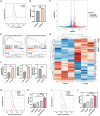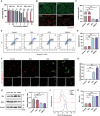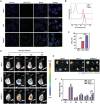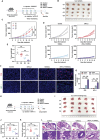A Smart Nanomedicine Unleashes a Dual Assault of Glucose Starvation and Cuproptosis to Supercharge αPD-L1 Therapy
- PMID: 39632613
- PMCID: PMC11775525
- DOI: 10.1002/advs.202411378
A Smart Nanomedicine Unleashes a Dual Assault of Glucose Starvation and Cuproptosis to Supercharge αPD-L1 Therapy
Abstract
Combination therapy has become a promising strategy for promoting the outcomes of anti-programmed death ligand-1 (αPD-L1) therapy in lung cancer. Among all, emerging strategies targeting cancer metabolism have shown great potency in treating cancers with immunotherapy. Here, alteration in glucose and copper metabolisms is found to synergistically regulate PD-L1 expression in lung cancer cells. Thus, an intelligent biomimetic nano-delivery system is synthesized by camouflaging lung cancer cell membranes onto glucose oxidase-loaded Cu-LDHs (CMGCL) for cancer metabolism targeted interference. Such novel nanomedicine is able to induce lung cancer cell cuproptosis and PD-L1 upregulation significantly via self-amplified cascade reactions. Meanwhile, with a decent cancer cell membrane coating, CMGCL exhibited great biosafety, tumor-targeted efficiency and anti-tumor effects in LLC lung tumor-bearing mice models. Additionally, a combination of CMGCL can sensitize the therapeutic effects of αPD-L1, substantially promoting tumor inhibition in both subcutaneous and lung metastasis LLC-bearing mice models. Overall, these findings highlight the potential connections between glucose metabolism and cell cuproptosis, offering a promising approach for treating lung cancer by integrating starvation, cuproptosis, and immunotherapy.
Keywords: PD‐L1; biomimetic nanomedicine; cuproptosis; glucose metabolisms; lung cancer.
© 2024 The Author(s). Advanced Science published by Wiley‐VCH GmbH.
Conflict of interest statement
The author declare no conflict of interest.
Figures









Similar articles
-
Novel Pt@PCN-Cu-induced cuproptosis amplifies αPD-L1 immunotherapy in pancreatic ductal adenocarcinoma through mitochondrial HK2-mediated PD-L1 upregulation.J Exp Clin Cancer Res. 2025 May 17;44(1):149. doi: 10.1186/s13046-025-03409-4. J Exp Clin Cancer Res. 2025. PMID: 40382627 Free PMC article.
-
Zinc-copper bimetallic nanoplatforms trigger photothermal-amplified cuproptosis and cGAS-STING activation for enhancing triple-negative breast cancer immunotherapy.J Nanobiotechnology. 2025 Feb 24;23(1):137. doi: 10.1186/s12951-025-03186-4. J Nanobiotechnology. 2025. PMID: 39994712 Free PMC article.
-
CD122-directed interleukin-2 treatment mechanisms in bladder cancer differ from αPD-L1 and include tissue-selective γδ T cell activation.J Immunother Cancer. 2021 Apr;9(4):e002051. doi: 10.1136/jitc-2020-002051. J Immunother Cancer. 2021. PMID: 33849925 Free PMC article.
-
Dual blockade immunotherapy targeting PD-1/PD-L1 and CTLA-4 in lung cancer.J Hematol Oncol. 2024 Jul 27;17(1):54. doi: 10.1186/s13045-024-01581-2. J Hematol Oncol. 2024. PMID: 39068460 Free PMC article. Review.
-
The Significance of the PD-L1 Expression in Non-Small-Cell Lung Cancer: Trenchant Double Swords as Predictive and Prognostic Markers.Clin Lung Cancer. 2018 Mar;19(2):120-129. doi: 10.1016/j.cllc.2017.10.014. Epub 2017 Oct 28. Clin Lung Cancer. 2018. PMID: 29153898 Review.
Cited by
-
Novel Pt@PCN-Cu-induced cuproptosis amplifies αPD-L1 immunotherapy in pancreatic ductal adenocarcinoma through mitochondrial HK2-mediated PD-L1 upregulation.J Exp Clin Cancer Res. 2025 May 17;44(1):149. doi: 10.1186/s13046-025-03409-4. J Exp Clin Cancer Res. 2025. PMID: 40382627 Free PMC article.
-
Emerging regulated cell death mechanisms in bone remodeling: decoding ferroptosis, cuproptosis, disulfidptosis, and PANoptosis as therapeutic targets for skeletal disorders.Cell Death Discov. 2025 Jul 21;11(1):335. doi: 10.1038/s41420-025-02633-3. Cell Death Discov. 2025. PMID: 40691135 Free PMC article. Review.
References
-
- Vesely M. D., Zhang T., Chen L., Annu. Rev. Immunol. 2022, 40, 45. - PubMed
MeSH terms
Substances
Grants and funding
LinkOut - more resources
Full Text Sources
Medical
Research Materials
